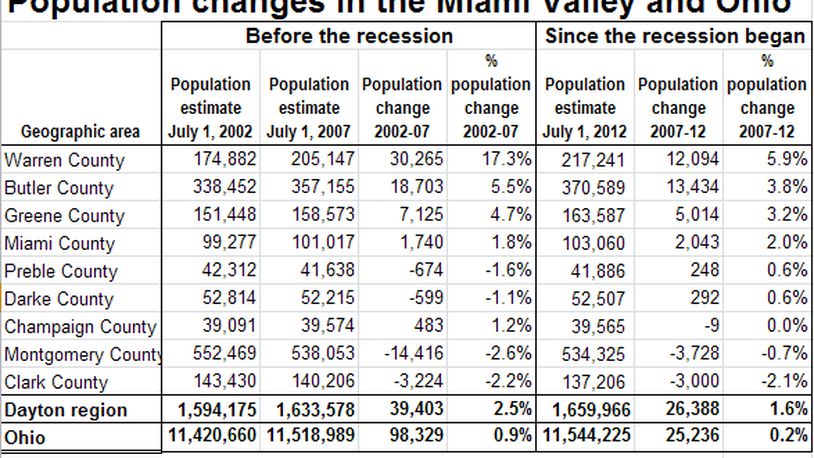One of the winners was Montgomery County, which has been steadily losing residents since 1970. The county’s population loss in the five years since the beginning of the recession was only about a quarter of what it had been during the five previous years. For the five years ending July 1, 2007, the region’s largest county had a population decline of 2.6 percent, or 14,416 people. But in the five years following the onset of the recession – which officially began in December 2007 and ended in June 2009 — the county shrank by only 0.7 percent, or 3,728 residents.
The same slowing population change was true for Warren County — which has been one of Ohio’s fastest-growing counties for decades and still ranked fourth in the state in percent population growth for the year ending July 1, 2012. The county’s growth from 2002 to 2007 was 17.3 percent, or more than 30,000 residents, but its growth since has been 5.9 percent, or just over 12,000.
Montgomery County Administrator Joe Tuss said the data was both good news and interesting, and not just for his county.
“I think the data shows that Montgomery County from a population standpoint is moving in the right direction and stabilizing,” Tuss said. “I think it’s also good the region as a whole is growing and continues to grow. Because … when you look at it from an economic standpoint, the economy really is a regional economy.”
Tuss said the data show the region has gained some stability “across the board.”
“While growth has slowed down in some of the high-growth counties, the reality is you can’t keep up with 17 percent growth rate,” Tuss said. “The reality is, in a state where the population growth is 0.2 percent, the fact that the Dayton region grew by 1.6 (percent) is good news.”
Tuss said the population data corresponds to local sales and income tax receipts, which have stabilized in many jurisdictions across the region.
“We’ve seen growth out of the recession, and we’re seeing relative stability in those local taxes that we actually have some control over,” he said.
Warren County Administrator Dave Gully wasn’t bemoaning the slowdown in his county’s growth.
“Aside from the economic impact on builders and realtors, we don’t necessarily see that as a bad thing,” he said. “Our growth was borderline out of control for a decade before the recession. We were constantly in a catchup mode.”
Gully said the “respite” gave the county time to update its zoning documents and master plans.
“It’ll come back,” he said, “but we’ll be in a better position to deal with it because we’ve had this break.”
Growth in Butler and Greene counties dropped by more than a quarter when comparing the two periods.
Clark County benefitted the least from the slowdown. For the five years before the recession, the county lost 3,224 people, 2.2 percent. For 2007 through 2012, it lost 3,000, 2.1 percent of its residents.
The smaller counties in the region showed mixed results with small changes. Miami County had slightly increased growth – from 1.8 percent or 1,740 residents for the five years before the recession, to 2.0 percent or 2,043 more residents for the five years after.
Preble and Darke counties went from losses to slight gains and Champaign County went from a slight gain to a very small loss.
About the Author
